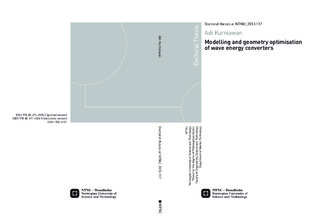| dc.contributor.author | Kurniawan, Adi | nb_NO |
| dc.date.accessioned | 2014-12-19T12:08:38Z | |
| dc.date.available | 2014-12-19T12:08:38Z | |
| dc.date.created | 2013-04-30 | nb_NO |
| dc.date.issued | 2013 | nb_NO |
| dc.identifier | 619095 | nb_NO |
| dc.identifier.isbn | 978-82-471-4335-3 (printed version) | nb_NO |
| dc.identifier.isbn | 978-82-471-4336-0 (electronic version) | nb_NO |
| dc.identifier.uri | http://hdl.handle.net/11250/238376 | |
| dc.description.abstract | The ultimate goal of wave energy undertaking is to find a solution that minimises the cost of delivered energy. Not only should a device maximise its energy absorption, but also the costs associated with absorbing and converting that energy into useful forms should be minimised. Towards realising this goal, this thesis contributes in three main areas, namely, numerical modelling, geometry optimisation, and geometry control.
The highlights of numerical modelling include the use of bond graph—a domain-independent, graphical representation of dynamical systems—in developing numerical models of wave energy converters (WECs), and the use of state-space models to represent the wave radiation terms. It is shown that bond graph is well-suited for modelling WECs, which involve interactions between multiple energy domains, and that state-space models of the wave radiation terms are efficient and sufficiently accurate for use in time-domain simulations of WECs. Both bond graph and state-space models are used in the modelling of a floating oscillating water column device, which, from the point of view of hydrodynamics, is a complex device involving various hydrodynamic radiation terms.
The main contribution of geometry optimisation is the incorporation of the cost factor in the design problem through the use of a multi-objective optimisation scheme. Two simplified cost factors are considered, namely, the surface area of the device and the reaction force that the device must withstand. The scheme is applied to find optimum geometries of a class of oscillating-body WECs that oscillate about a fixed horizontal axis. It is shown that when the cost factor is taken into account, a design that maximises the absorbed power is not necessarily the most economical. It is found, for example, that an economical bottom-hinged device has its section spanning only part of the water depth instead of the whole water depth.
Informed by the results of the geometry optimisation study, a design is proposed of a device which allows its geometry to be varied from time to time depending on the prevailing wave condition. An investigation of the device characteristics and potential is reported under geometry control. It is shown that controlling the variation of the geometry has the potential of broadening the power absorption bandwidth and improving its capacity factor in extreme conditions. | nb_NO |
| dc.language | eng | nb_NO |
| dc.publisher | Norges teknisk-naturvitenskapelige universitet, Fakultet for ingeniørvitenskap og teknologi, Institutt for marin teknikk | nb_NO |
| dc.relation.ispartofseries | Doktoravhandlinger ved NTNU, 1503-8181; 2013:117 | nb_NO |
| dc.relation.haspart | Kurniawan, Adi; Pedersen, Eilif; Moan, Torgeir. Bond graph modelling of a wave energy conversion system with hydraulic power take-off. Renewable energy. (ISSN 0960-1481). 38(1): 234-244, 2012. <a href='http://dx.doi.org/10.1016/j.renene.2011.07.027'>10.1016/j.renene.2011.07.027</a>. | nb_NO |
| dc.relation.haspart | Kurniawan, Adi; Hals, Jørgen; Moan, Torgeir. Modelling and Simulation of a Floating Oscillating Water Column (OMAE2011-49263).. 30th International Conference on Ocean, Offshore and Arctic Engineering - Vol. V: 395-406, 2011. | nb_NO |
| dc.relation.haspart | Kurniawan, Adi; Hals, Jørgen; Moan, Torgeir. Assessment of Time-Domain Models of Wave Energy Conversion Systems. Proceedings of the 9th European Wave and Tidal Energy Conference, 2011. | nb_NO |
| dc.relation.haspart | Kurniawan, Adi; Moan, Torgeir. Optimal Geometries for Wave Absorbers Oscillating About a Fixed Axis. IEEE Journal of Oceanic Engineering. (ISSN 0364-9059). 38(1): 117-130, 2013. <a href='http://dx.doi.org/10.1109/JOE.2012.2208666'>10.1109/JOE.2012.2208666</a>. | nb_NO |
| dc.relation.haspart | Kurniawan, Adi; Moan, Torgeir. Characteristics of a Pitching Wave Absorber with Rotatable flap. Energy Procedia. (ISSN 1876-6102). 20: 134-147, 2012. <a href='http://dx.doi.org/10.1016/j.egypro.2012.03.015'>10.1016/j.egypro.2012.03.015</a>. | nb_NO |
| dc.relation.haspart | Kurniawan, Adi; Moan, Torgeir. Multi-objective optimization of a wave energy absorber geometry. Proceedings - 27th International Workshop on Water Waves and Floating Bodies: 93-96, 2012. | nb_NO |
| dc.relation.haspart | Kurniawan, Adi; Pedersen, Eilif; Moan, Torgeir. Modeling of Wave Energy Converters Using Bond Graph. 10th International Conference on Bond Graph Modeling and Simulation 2012.: 195-202, 2012. | nb_NO |
| dc.title | Modelling and geometry optimisation of wave energy converters | nb_NO |
| dc.type | Doctoral thesis | nb_NO |
| dc.contributor.department | Norges teknisk-naturvitenskapelige universitet, Fakultet for ingeniørvitenskap og teknologi, Institutt for marin teknikk | nb_NO |
| dc.description.degree | PhD i marin teknikk | nb_NO |
| dc.description.degree | PhD in Marine Technology | en_GB |

